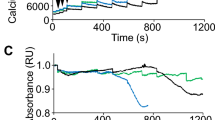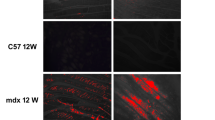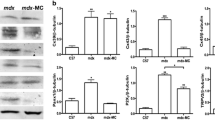Abstract
Membrane-mediated excessive intracellular calcium accumulation (EICA) and diminished cellular energy production are the hallmarks of dystrophic pathobiology in Duchenne and Becker muscular dystrophies. We reported reversal of respiratory damage and Ca2+-overloading in the in vitro cardiac mitochondria from CHF-146 dystrophic hamsters (DH) with hereditary muscular dystrophy (Bhattacharya et al., 1993). Here we studied respiratory dysfunctions in the skeletal muscle mitochondria from young and old DH, and whether these abnormalities can be reversed by reducing [Ca2+] in the isolation medium, thereby lowering intramitochondrial Ca2+-overloading. Age- and sex-matched CHF-148 albino normal hamsters (NH) served as controls. As an index of EICA and cellular degeneration, Ca and Mg levels were assayed in the skeletal muscle and mitochondria. Mitochondria from young and old DH, isolated without EDTA (Bo medium), revealed poor coupling of oxidative phosphorylation, diminished stimulated oxygen consumption rate, and lower respiratory control ratio and ADP/O ratios, compared to NH. Incorporation of 10 mM EDTA (BE medium) in the isolation medium restored mitochondrial functions of the dystrophic organelles to a near-normal level, and reduced Ca2+-overloading. The mitochondrial Ca level in DH was significantly higher than in NH, irrespective of the medium. However, compared to Bo medium, the dystrophic organelles isolated in BE medium had lower Ca levels and markedly improved oxidative phosphorylation as seen in NH. Muscle Ca contents in the young and old DH were elevated relative to NH, showing a positive correlation with the increased mitochondrial Ca2+-sequestration. Dystrophic muscle also revealed Ca deposition with an abundance of Ca2+-positive and necrotic myofibers by light microscopy, and intramitochondrial Ca2+-overloading by electron microscopy, respectively. However, Mg levels in the muscle and mitochondria did not alter with age or dystrophy. These data parallel our observations in the heart, and suggest that functional impairments and Ca2+-overloading also occur in the skeletal muscle mitochondria of DH, and are indeed reversible if EICA is regulated by slow Ca2+-channel blocker therapy (Johnson and Bhattacharya, 1993).
Similar content being viewed by others
Abbreviations
- DH:
-
dystrophic hamsters
- NH:
-
normal hamsters
- ADP/O ratio:
-
adenosine diphosphate to oxygen ratio
- EDTA:
-
ethylenediaminetetraacetic acid
- EICA:
-
excessive intracellular calcium accumulation
- HMD:
-
hereditary muscular dystrophy
- RCR:
-
respiratory control ratio
- DMD:
-
Duchenne muscular dystrophy
- BMD:
-
Becker muscular dystrophy
References
Arahata K., Ishiura S., Ishiguro T., Tsukahara T., Suhara Y., Eguchi C., et al. (1988) Immunostaining of skeletal and cardiac muscle surface membrane with antibody against Duchenne muscular dystrophy peptide.Nature 333, 861–863.
Bajusz E., Baker J. R., Nixon C. W., and Homburger F. (1969) Spontaneous hereditary myocardial degeneration and congestive heart failure in a strain of Syrian hamsters.Ann. NY Acad. Sci. 156, 105–129.
Bertorini T. E., Bhattacharya S. K., Palmieri G. M. A., Chesney C. M., Pifer D., and Baker B. (1982) Muscle calcium and magnesium content in Duchenne muscular dystrophy.Neurology 32, 1988–1092.
Bertorini T. E., Cornelio F., Bhattacharya S. K., Palmieri G. M. A., Dones I., Dworzak F. et al. (1984) Calcium and magnesium content in fetuses at risk and prenecrotic Duchenne muscular dystrophy.Neurology 34, 1436–1440.
Bhattacharya S. K., Williams J. C., and Palmieri G. M. A. (1979) Determination of calcium and magnesium in cardiac and skeletal muscles by atomic absorption spectroscopy using stoichiometric nitrous oxide-acetylene flame.Anal. Lett. 12, 1451–1475.
Bhattacharya S. K., Palmieri G. M. A., Bertorini T. E., and Nutting D. F. (1982) The effect of diltiazem in dystrophic hamsters.Muscle Nerve 5, 73–78.
Bhattacharya S. K., Crawford A. J., and Pate J. W. (1987) Electrocardiographic, biochemical and morphologic abnormalities in dystrophic hamsters with cardiomyopathy.Muscle Nerve 10, 168–176.
Bhattacharya S. K., Crawford A. J., Thakar J. H., and Johnson P. L. (1989) Pathogenetic roles of intracellular calcium and magnesium in membrane-mediated progressive muscle degeneration in Duchenne muscular dystrophy, inCell Calcium Metabolism (Fiskum G., ed.), pp. 513–5254, Plenum, New York.
Bhattacharya S. K., Thakar J. H., Johnson P. L., and Shanklin D. R. (1991) Isolation of skeletal muscle mitochondria from hamsters using an ionic medium containing ethylenediaminetetraacetic acid and Nagarse.Anal. Biochem. 192, 344–349.
Bhattacharya S. K., Johnson P. L., Gupta M. P., and Handa R. K. (1992) Role of ADP phosphorylating, glycolytic and key mitochondrial enzymes in cellular energetics of cardiac and skeletal muscle of dystrophic hamsters with cardiomyopathy.Soc. Neurosci. Abstracts 18, 1593.
Bhattacharya S. K., Johnson P. L., and Thakar J. H. (1993) Reversal of impaired oxidative phosphorylation and calcium overloading in the in vitro cardiac mitochondria of CHF-146 dystrophic hamsters with hereditary muscular dystrophy.J. Neurol. Sci. 120, 180–186.
Bhattacharya S. K., Johnson P. L., Li H. J., Handa R. K., and Adamec T. A. (1997) Reduced sarcolemmal dystrophin distribution and upregulation of utrophin in the cardiac and skeletal muscles of CHF-146 dystrophic hamsters.Mol. Chem. Neuropathol. 31, 187–206.
Bonilla E., Samitt C. E., Miranda A. F., Hays A. P., Salviati G., DiMauro S., et al. (1988) Duchenne muscular dystrophy: Deficiency of dystrophin at the muscle cell surface.Cell 54, 447–452.
Chance B. and Williams G. R. (1956) The respiratory chain and oxidative phosphorylation.Adv. Enzymol. 17, 65–134.
Dhalla N. S. (1976) Involvement of membrane systems in heart failure due to intracellular calcium overload and deficiency.J. Mol. Cell. Cardiol. 8, 661–667.
Estabrook R. W. (1967) Mitochondrial respiratory control and the polarographic measurement of ADP/O ratios, inMethods in Enzymology (Estabrook R. W. and Pullman M. E., eds.), pp. 41–47, Academic, New York.
Fong P., Turner P. R., Denetclaw W. F., and Steinhard R. A. (1990) Increased activity of calcium leak channels in myotubes of Duchenne human and mdx mouse origin.Science 250, 673–676.
Franco A. and Lansman J. B. (1990) Calcium entry through stretch-inactivated ion channels in mdx myotubes.Nature 344, 670–673.
Hoffman E. P., Brown R. H., and Kunkel L. M. (1987) Dystrophin: The protein product of the Duchenne muscular dystrophy locus.Cell 51 919–928.
Hoppel C. L., Tandler B., Parland W., Turkaly J. S., and Albers L. D. (1982) A defect in oxidative phosphorylation in the cardiac interfibrillar mitochondria.J. Biol. Chem. 257, 1540–1548.
Hunter E. G., Hughes V., and White, J. (1984) Cardiomyopathic hamsters, CHF-146 and CHF-147: a preliminary study.J. Physiol. Pharmacol. 62, 1423–1428.
Iwata Y., Nakamura H., Fujiwara K., and Shigekawa M. (1993) Altered membrane-dystrophin association in the cardiomyopathic hamster heart muscle.Biochem. Biophys. Res. Commun. 190, 589–595.
Johnson P. L. and Bhattacharya S. K. (1993) Regulation of membrane-mediated chronic muscle degeneration in dystrophic hamsters by calcium-channel blockers: Diltiazem, Nifedipine and Verapamil.J. Neurol. Sci. 115, 76–90.
Le Rumeur E., Le Tallec N., Lewa C. J., Ravalec X., and de Certaines J. D. (1995) In vivo evidence of abnormal mechanical and oxidative functions in the exercised muscle of dystrophic hamsters by 31P-NMR.J. Neurol. Sci. 133, 16–23.
Lochner A., Brink A. J., and Van der Walt J. J. (1970) The significance of biochemical and structural changes in the development of the myocardiopathy of the Syrian hamster.J. Mol. Cell. Cardiol. 1, 47–64.
Lossnitzer K. and Bajusz E. (1974) Water and electrolyte alterations during the life course of the BIO 14.6 Syrian golden hamster. A disease model of a hereditary cardiomyopathy.J. Mol. Cell. Cardiol. 6, 163–177.
Lowry O. H., Rosebrough N. J., Farr A. C., and Randall R. J. (1951) Protein measurement with Folin phenol reagent.J. Biol. Chem. 193, 265–275.
Matsumura K. and Campbell K. P. (1993) Deficiency of dystrophin-associated proteins: A common mechanism leading to muscle cell necrosis in severe childhood muscular dystrophies.Neuromuscular Disord 3, 109–118.
Matsumura K. and Campbell K. P. (1994) Dystrophin-glycoprotein complex: Its role in the molecular pathogenesis of muscular dystrophies.Muscle Nerve 17, 2–15.
Mizuno Y., Yoshida M., Nonaka I., Hirai S., and Ozawa E. (1994) Expression of utrophin (Dystrophin-related protein) and dystrophin-associated glycoproteins in muscles from patients with Duchenne muscular dystrophy.Muscle Nerve 17, 206–216.
Ohlendieck K., Matsumura K., Ionasescu V. V., Towbin J. A., Bosch E. P., Weinstein S. L., et al. (1993) Duchenne muscular dystrophy: Deficiency of dystrophin-associated proteins in the sarcolemma.Neurology 43, 795–800.
Paterson R. A., Layberry R. A., and Nadkarni B. B. (1972) Cardiac failure in the hamster: a biochemical and electron microscopic study.Lab. Invest. 26, 755–766.
Peng C. F., Kane J. J., Murphy M. L., and Straub K. D. (1977) Abnormal mitochondrial oxidative phosphorylation of ischemic myocardium reversed by Ca2+-chelating agents.J. Mol. Cell. Cardiol. 9, 897–908.
Peterson G. L. (1977) A simplification of the protein assay method of Lowry et al. which is more generally applicable.Anal. Biochem. 83, 346–356.
Roberds S. L., Ervasti J. M., Anderson R. D., Ohlendieck K., Kahl S. D., Zoloto D., et al. (1993) Disruption of the dystrophin-glycoprotein complex in the cardiomyopathic hamster.J. Biol. Chem. 268, 11,496–11,499.
Sanyal S. K., Johnson W. W., Dische M. R., Pitner S. E., and Beard C. (1980) Dystrophic degeneration of papillary muscle and ventricular myocardium: a basis for mitral valve prolapse in Duchenne's muscular dystrophy.Circulation 62, 430–438.
Schwartz A., Lindenmayer G. E., and Harigaya S. (1968) Respiratory control and calcium transport in heart mitochondria from the cardiomyopathic Syrian hamster.Trans. NY Acad. Sci. 30, 951–954.
Thakar J. H., Wrogemann K., and Blanchaer M. C. (1973) Effect of ruthenium red on oxidative phosphorylation and the calcium and magnesium content of skeletal muscle mitochondria of normal and BIO 14.6 dystrophic hamsters.Biochim. Biophys. Acta 314, 8–14.
Uusimaa P. A., Peuhkurinen K. J., Vuolteenaho O., Ruskoaho H., and Hassinen I. E. (1992) Role of myocardial redox and energy states in ischemia-stimulated release of atrial patriuretic peptide.J. Mol. Cell. Cardiol. 24, 191–205.
Wrogemann K. and Nylen E. G. (1978) Mitochondrial calcium overloading in cardiomyopathic hamsters.J. Mol. Cell. Cardiol. 10, 185–195.
Wrogemann K., Blanchaer M. C., and Jacobson B. E. (1970) A calcium-associated magnesium-responsive defect of respiration and oxidative phosphorylation by skeletal muscle mitochondria of BIO 14.6 dystrophic hamsters.Life Sci. 9, 1167–1173.
Yamanouchi Y., Mizuno Y., Yamamoto H., Takemitsu M., Yoshida M., Nonaka I., et al. (1994) Selective defect in dystrophin-associated glycoproteins 50DAG (A2) and 35DAG (A4) in the dystrophic hamster: an animal model for severe childhood autosomal recessive muscular dystrophy (SCARMD).Neuromuscular Disord. 4, 49–54.
Author information
Authors and Affiliations
Corresponding author
Rights and permissions
About this article
Cite this article
Bhattacharya, S.K., Johnson, P.L. & Thakar, J.H. Reversal of impaired oxidative phosphorylation and calcium overloading in the skeletal muscle mitochondria of CHF-146 dystrophic hamsters. Molecular and Chemical Neuropathology 34, 53–77 (1998). https://doi.org/10.1007/BF02815136
Received:
Revised:
Accepted:
Issue Date:
DOI: https://doi.org/10.1007/BF02815136




